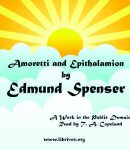
Amoretti and Epithalamion
“These Sonnets furnish us with a circumstantial and very interesting history of Spenser’s second courtship, which, after many repulses, was successfully terminated by the marriage celebrated in the Epithalamion. As these poems were entered in the Stationers’ Registers on the 19th of November, 1594, we may infer that they cover a period of time extending from the end of 1592 to the summer of 1594. It is possible, however, that these last dates may be a year too late, and that Spenser was married in 1593. We cannot be sure of the year, but we know, from the 266th verse of the Epithalamion, that the day was the feast of St. Barnabas, June 11 of the Old Style. In the 74th sonnet, we are directly told that the lady’s name was Elizabeth. In the 61st, she is said to be of the “Brood of Angels, heavenly born.” From this and many similar expressions, interpreted by the laws of Anagram, and taken in conjunction with various circumstances which do not require to be stated here, it may be inferred that her surname was Nagle.” (Summary by Francis James Childe) [chương_files]
